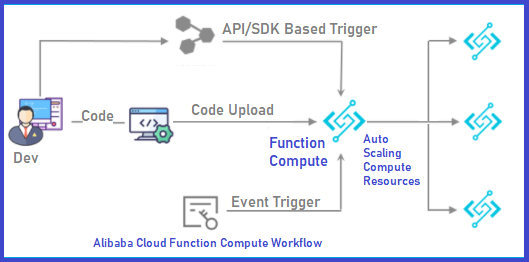By Raghav K.
During the past few years, trends have suggested that the majority of organizations will become serverless. Serverless computing works toward changing the way businesses operate. It works to add to the overall technological effectiveness that leads to a better optimized service and solution cycle.
Serverless computing eases the approach for an organization to strategize future plans and opens up the possibilities of multi-cloud adoption and better optimized software delivery cycles. In recent years, serverless technology has been developing rapidly with a significant increase in usability rate. Alibaba Cloud has worked towards enriching its cloud service based on serverless technology and a wide array of development tools that ensure optimized application delivery pipelines, metrics collection, and better integration scenarios.
Alibaba Cloud Function Compute is a fully-managed compute service that doesn't require the user to work for any resources or O&M needs. Developers can run their code flexibly and reliably without infrastructure management. Function Compute automatically adjusts the resources based on the traffic demand. It uses a reserved instance for further performance acceleration. Alongside maintaining latency glitches, this reserved instance also helps with easy online application migration to Function Compute.
Triggers can be invoked by the Function Compute SDK, API, API Gateway, Object Storage Service (OSS), Log Service, or Table Store. As a result of these services, a developer has all of the necessary tools and services to build elastic, reliable, and feature-rich applications.
The workflow for Function Compute is shown below:

1. Simplifies Application Stack
Serverless computing takes care of all the complexities of server-centric application management and provides a robust framework for agile application development. Function Compute has been the prime example of delivering high-quality computing that is highly-scalable.
2. Managed Computing
Serverless computing is designed to offer a fully-managed service environment that frees the developer from any overhead tasks of provisioning resources or maintaining the backend. Developers can build an application and deploy it without any hassle. This allows the organizations to promote the autonomy of operations by focusing on the core business values.
3. Shorter Release Cycles
Microservices are the driving forces behind serverless computing. Microservices enable the organization to isolate different modules of an application and make changes without any downtime. Build cycles and deployment times are accelerated. As a result, the release cycle changes considerably.
4. Expense Cutdown
Traditional data centers or physical infrastructure management can lead to tedious O&M expenses. Serverless is a fully-managed system and helps cut down on the organization's total IT infrastructure expense by a huge margin.
There is still a lot to explore with Serverless computing. It showcases high-potential with concepts like Backend as a Service (BaaS) and Function as a Service (FaaS). We believe organizations should expect a massive surge in serverless scenarios in the near future. Cloud computing has introduced a highly virtualized approach to server modules with several benefits.
These are some future serverless computing trends for you to consider:
1. Serverless as a Whole
Most of the complex and technical solutions will be implemented as fully-managed serverless computing solutions. An API-plus-serverless mode will enable serverless as a whole scenario for enterprises. Platform strategies will be able to incorporate serverless architecture within their products with APIs to provide features. One example of this scenario is DingTalk.
2. Cloud Connect Event-Driven
An event-driven connection to the cloud is one of the most important benefits of the serverless computing system. These capabilities are expected to extend to the whole cloud ecosystem. Developers can enable the enterprise applications that are stored in an on-premises environment or a public cloud to be processed in a serverless environment. Cloud services with serverless processing can help build applications with high-scalability and high-availability.
3. JVMs at the Wheel
Java virtual machine (JVM) has evolved and significantly improved Java application start-up speed, including efficient memory usage with instances or processors and operating systems working together. JVMs at the wheel will be able to isolate any performance glitches in dense environments. These trends will account for a new, improved, and more powerful computing environment that costs less with minimum resource usage.
4. Hardware Serverless
Scenarios that require high computing capabilities, such as AI, Big Data analytics, and video streaming/processing, will become more mainstream. The added technological innovation will require even more resources than before. Dedicated resources could seem like the only option for developers. In that situation, concepts, such as hardware virtualization, resource pooling, application framework support, and resource scheduling, can help with serverless hardware releases and lower the technical threshold for developers.
5. Serverless Kubernetes
Kubernetes has grown massively since its release. The open-source tech has grown considerably and is already being considered as a massive player with multi-cloud. Kubernetes could become the go-to player for serverless computing. Kubernetes' agility and scalability could play a vital role with serverless technology.
6. High-Performance Computing – Minimum Resource Usage
Serverless computing is expected to develop and become more efficient. Virtual machines (VMs) and containers provide virtualization tech but also vary significantly in costs. VMs are secure but cost a lot more, andcontainers need additional security but cost a lot less. Serverless computing platforms require high security measures and minimum resource usage. This could be one of the best trends to watch out for with serverless computing.
7. Stateful Serverless
Stateful applications will leverage the power of serverless computing. Backend as a Service (BaaS) will play a vital role, and the developer will be able to implement using serverless architecture for their stateful applications.
Serverless platforms have to be compatible with the original program execution methods. When combined with resource scheduling to enable load balancing for applications, the virtualization technology provides a strong backend and ensures stable performance. Alibaba Cloud has curated the serverless solution in a way that will increase in scale. The industry is already sensing the impact of serverless computing, and it will increase over time.
At this stage, end-to-end optimization is highly critical. At different layers of an application framework, optimization defines the characteristics of the serverless workload. This highly stable system can provide a robust infrastructure that is fully-managed with a no-nonsense computing architecture.

2,599 posts | 764 followers
FollowAlibaba Developer - March 3, 2020
Alibaba Developer - March 3, 2020
Alibaba Developer - March 3, 2020
Alibaba Developer - February 9, 2021
Alibaba Clouder - July 27, 2020
Alibaba Clouder - October 21, 2020

2,599 posts | 764 followers
Follow Function Compute
Function Compute
Alibaba Cloud Function Compute is a fully-managed event-driven compute service. It allows you to focus on writing and uploading code without the need to manage infrastructure such as servers.
Learn More ECS(Elastic Compute Service)
ECS(Elastic Compute Service)
Elastic and secure virtual cloud servers to cater all your cloud hosting needs.
Learn More Serverless Workflow
Serverless Workflow
Visualization, O&M-free orchestration, and Coordination of Stateful Application Scenarios
Learn More Serverless Application Engine
Serverless Application Engine
Serverless Application Engine (SAE) is the world's first application-oriented serverless PaaS, providing a cost-effective and highly efficient one-stop application hosting solution.
Learn MoreMore Posts by Alibaba Clouder